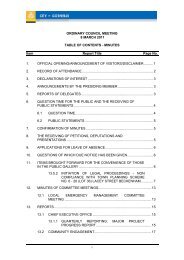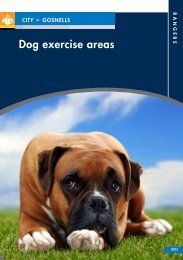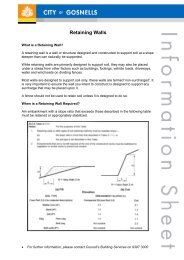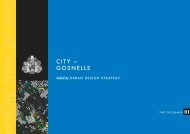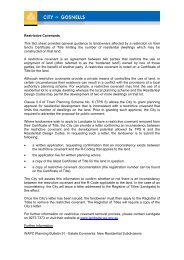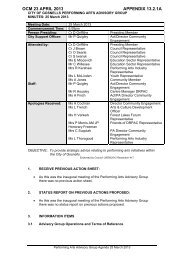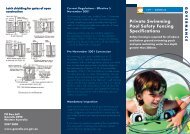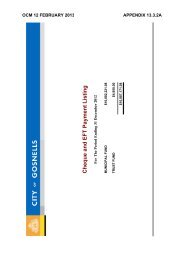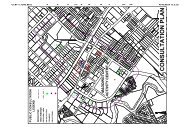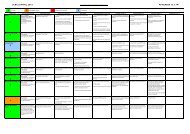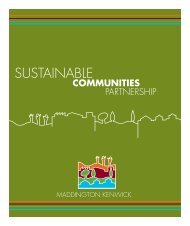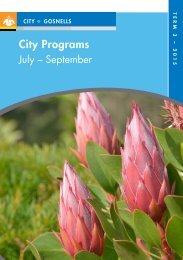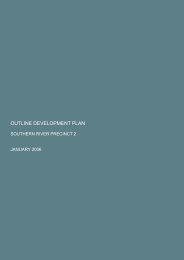Summary - City of Gosnells
Summary - City of Gosnells
Summary - City of Gosnells
You also want an ePaper? Increase the reach of your titles
YUMPU automatically turns print PDFs into web optimized ePapers that Google loves.
Flora 354.1.1.2 Flora <strong>of</strong> State SignificanceWestern Australian Wildlife Conservation Act 1950 (WA Conservation Act) and Western AustralianDepartment <strong>of</strong> Environment and Conservation (WA DEC) Priority Flora Taxa.Declared Rare Flora (DRF) taxa are protected under the Western Australia Conservation Act. The list <strong>of</strong> taxacurrently protected under this Act was gazetted in Government Gazette, WA (2008). DRF taxa are assessedunder the same international criteria as EPBC listed species. Therefore, if a species is listed as DRF inWestern Australia, it is also eligible for listing under the EPBC Act and should be listed as such as soon asthe required administrative process is completed.The Western Australian DEC has also defined four classes <strong>of</strong> Priority Flora Taxa that are considered to be <strong>of</strong>conservation significance (Atkins, 2008). These taxa are grouped into four categories (Priority One, PriorityTwo, Priority Three and Priority Four) depending on the perceived urgency <strong>of</strong> determining their formalconservation status as indicated by the degree <strong>of</strong> threat to these taxa. (See Appendix A for the definitions <strong>of</strong>Declared Rare Flora and the four categories <strong>of</strong> Priority Flora.)Ten Declared Rare Flora taxa are known from the vicinity <strong>of</strong> the MKSEA survey area (Appendix A, TableA1). These species are the same as the EPBC listed species for this area. Forty-five Priority Species areknown from the same area, <strong>of</strong> which 24 have been recorded from BFS 387.One species that is currently listed as Priority 4 by DEC, Grevillea thelemanniana, has recently beenconfirmed as being restricted entirely to the Kenwick-Wattle Grove area, an extremely small range for anyspecies (B. Makinson, 2009, pers. comm; P. Olde, 2009, pers. comm.). When this narrow range is consideredin the context <strong>of</strong> the level <strong>of</strong> threat that is experienced by native flora in this setting, Grevillea thelemannianais eligible for Declared Rare Flora status and, at least, Endangered status under the EPBC Act.Trudgen and Keighery (1995, Table 1) list 41 taxa <strong>of</strong> Declared Rare and Priority Flora recorded in the part <strong>of</strong>the <strong>City</strong> <strong>of</strong> <strong>Gosnells</strong> west <strong>of</strong> the Darling scarp and another 11 that may occur there. Fifteen <strong>of</strong> these 52 taxaare listed as endemic to alluvial soils on the eastern side <strong>of</strong> the SCP.4.1.1.3 Flora <strong>of</strong> Regional SignificanceEPA (2004b) and (Government <strong>of</strong> Western Australian, 2000) have nominated a number <strong>of</strong> other criteria(apart from the Federal and Western Australian State criteria <strong>of</strong> Threatened Flora, Declared Rare Flora andPriority Species) under which flora taxa (i.e. species, sub-species and varieties) may have conservationsignificance. In EPA (2004b) such taxa are termed ‘other taxa <strong>of</strong> conservation significance’. These criteriaare not explained well in EPA (2004b) and can be somewhat difficult to understand without furtherexplanation. Essentially, the conservation significance <strong>of</strong> such taxa is assessed primarily by considering theirstatus in the context <strong>of</strong> a single region (i.e. the Swan Coastal Plain Bioregion when examining the MKSEA),rather than in the context <strong>of</strong> the whole <strong>of</strong> Western Australia or Australia. Thus in the MKSEA study, suchtaxa were termed ‘regionally significant’ rather than ‘other taxa <strong>of</strong> conservation significance’ because theformer term was thought to be more descriptive and easier to understand. The criteria for the conservationsignificance <strong>of</strong> these taxa (from EPA, 2004b) and how they apply to the Maddington-Kenwick area in thecontext <strong>of</strong> the SCP are briefly explained below.1. Taxa with populations in Maddington-Kenwick that are significant (with reference to the SCP).Significant populations in this context are populations that are important in maintaining the survival <strong>of</strong>these taxa on the eastern SCP (or, more generally, on the SCP). There are potentially many reasons thatmay ensure that one population is <strong>of</strong> higher conservation significance than other populations <strong>of</strong> the samespecies in the region. For example, a large population may be <strong>of</strong> high regional significance if the otherpopulations in the region are very small. A mature population <strong>of</strong> obligate re-seeding plants with anabundant soil seed bank may be <strong>of</strong> high regional significance if most other populations in the regionhave been burnt recently and could be extirpated by another fire. A population that occurs in a wetlandreserve with an adequate buffer zone and has good connectivity to suitable habitat in other wetlandreserves nearby can be <strong>of</strong> higher regional significance than a population that is confined to the edges <strong>of</strong>drains along road verges. Other factors to consider in assessing regional significance <strong>of</strong> populationsTauss, C. and Weston, A.S. (2010). The flora, vegetation and wetlands <strong>of</strong> the Maddington-Kenwick Strategic Employment Area.A survey <strong>of</strong> the rural lands in the vicinity <strong>of</strong> the Greater Brixton Street Wetlands. Report to the <strong>City</strong> <strong>of</strong> <strong>Gosnells</strong>, W.A. Version 18.04.10



